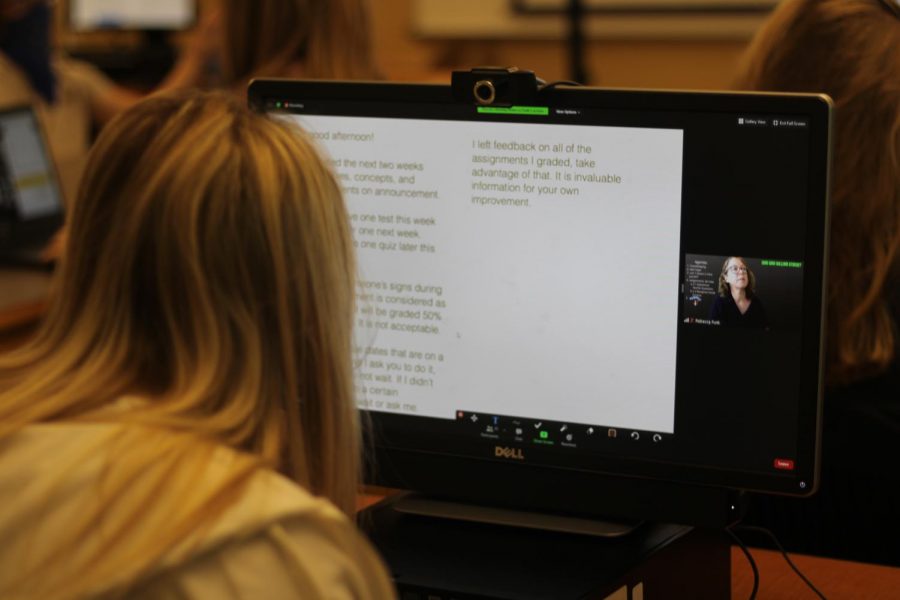Boerne ISD students were given the opportunity this year to take a newly-offered language class, American Sign Language (ASL); students who are enrolled in ASL learn a new language, immerse themselves in a new culture, and gain benefits in everyday life.
The computer lab by the library was once an extra computer lab, but now hosts the American Sign Language class. The class is conducted through a video call from virtual instructor Ms. Rebecca Funk, or—as her students call her—Ms. Rebecca, since first names are used in sign language.
“I love ASL,” said Ms. Rebecca. “I think ASL is an important visual language. I also want students to discover ASL.”
Ms. Rebecca went deaf at just a few days old; ASL is her first language.
“I grew up with both worlds—hearing and Deaf worlds,” said Ms. Rebecca. Ms. Rebecca is mostly Deaf and uses ASL to communicate, but can hear a small amount. “I learned how to live in both worlds. Hearing culture and Deaf culture are two very different cultures. English is my second language and is, and always will be, a lifelong learning process.”
To teach, Ms. Rebecca gestures, types on a screen, and signs; her class signs along with her. For most of the period the only English spoken are questions to other students or to the teaching assistant, who is in the room with students..
“What I really enjoy about the class is how easy Ms. Rebecca makes learning ASL,” said sophomore Kayla Lange. “While it is still hard to remember some things, she goes at a pace slow enough that I can understand everything, but fast enough that we aren’t repeating one thing for weeks.”
Despite this, having a teacher instruct remotely creates learning challenges.
“ASL is better taught in person, 3D presentation,” said Ms. Rebecca. “However, I manage to present signs in angles by repositioning myself on the screen a few times to show signs from a few different views.”
American Sign Language is the third-most studied language in the United States. Many people in the Deaf community rely on others’ knowledge of sign language for everyday communication.
“I am an advocate for diversity. I am also an advocate for ASL,” said Ms. Rebecca. “American Sign Language is a beautiful language found in Deaf culture. I have seen both hearing and Deaf people thrive well using ASL. I have a strong belief where all Deaf and Hard of Hearing (Deaf/HH) children should have access to ASL.”
The decision to add a sign language course developed over time.
“We’ve been thinking about adding a third language for several years,” said head of the Language Other Than English (LOTE) department Mrs. Lindsay Johnson. “Not only does [ASL] help you with critical thinking skills in other academic areas but it is a huge asset to your future career and your time in college.”
Ms. Rebecca regularly teaches the importance of ASL by incorporating Deaf culture. Students learn the history of sign language, notable Deaf people, everyday life being Deaf, and other topics. Much of the curriculum is devoted to the realities of ASL and being Deaf.
“Taking American Sign Language class has a significant impact,” says Ms. Rebecca. “The more people know ASL, the better communication would be in our society.”
This story was originally published on Charger Ink on December 4, 2020.































![IN THE SPOTLIGHT: Junior Zalie Mann performs “I Love to Cry at Weddings,” an ensemble piece from the fall musical Sweet Charity, to prospective students during the Fine Arts Showcase on Wednesday, Nov. 8. The showcase is a compilation of performances and demonstrations from each fine arts strand offered at McCallum. This show is put on so that prospective students can see if they are interested in joining an academy or major.
Sweet Charity originally ran the weekends of Sept. 28 and Oct. 8, but made a comeback for the Fine Arts Showcase.
“[Being at the front in the spotlight] is my favorite part of the whole dance, so I was super happy to be on stage performing and smiling at the audience,” Mann said.
Mann performed in both the musical theatre performance and dance excerpt “Ethereal,” a contemporary piece choreographed by the new dance director Terrance Carson, in the showcase. With also being a dance ambassador, Mann got to talk about what MAC dance is, her experience and answer any questions the aspiring arts majors and their parents may have.
Caption by Maya Tackett.](https://bestofsno.com/wp-content/uploads/2024/02/53321803427_47cd17fe70_o-1-1200x800.jpg)
![SPREADING THE JOY: Sophomore Chim Becker poses with sophomores Cozbi Sims and Lou Davidson while manning a table at the Hispanic Heritage treat day during lunch of Sept 28. Becker is a part of the students of color alliance, who put together the activity to raise money for their club.
“It [the stand] was really fun because McCallum has a lot of latino kids,” Becker said. “And I think it was nice that I could share the stuff that I usually just have at home with people who have never tried it before.”
Becker recognizes the importance of celebrating Hispanic heritage at Mac.
“I think its important to celebrate,” Becker said. “Because our culture is awesome and super cool, and everybody should be able to learn about other cultures of the world.”
Caption by JoJo Barnard.](https://bestofsno.com/wp-content/uploads/2024/01/53221601352_4127a81c41_o-1200x675.jpg)






